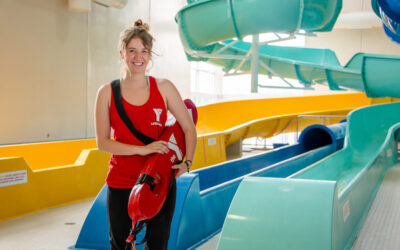
Dylan finds a comfortable spot and settles in to hear a story about star-crossed lovers who must fight for their lives in a sinister science fiction future. He pricks up his ears at certain passages but, otherwise, he is impassive, seemingly entranced by the tale. When words are mispronounced, he never corrects or criticizes. He is an attentive listener. Or at least, it appears that way.
Dylan, a smooth-haired collie, participates in the Therapy Animals Involved in Literacy Support (TAILS) program. Through TAILS, children are paired with therapy dogs once a week to improve reading skills and gain confidence through practice. The program is administered by St. John Ambulance (SJA) www.sja.ca, which provides intensive training for dogs. In the BC Interior, TAILS is available at schools in Vernon, Salmon Arm, Kelowna, Kamloops and Nelson. Every other week, Dylan and his owner Ellen Boelcke visit the only school in Kelowna that currently offers the program.
On this day at KLO Middle, Malachi, an energetic Grade 7 student, is clearly pleased to see his visitors. He chats with Ellen about gym class while the normally subdued dog jostles for attention, pressing up against the boy’s leg, tail wagging happily. Malachi pets the dog and says it’s nice to spend time with him since he can’t have a dog of his own. When he takes a seat on the couch, Dylan jumps up beside him (something he is never allowed to do at home). Within seconds, the dog adjusts to his therapy role. Malachi takes Hunger Games off the shelf and begins reading.
The response to the program from volunteers, students and parents has been overwhelmingly positive. During her two years of volunteering, Ellen has seen improvement in students’ reading ability, vocabulary and confidence. As for her dog, she laughs and says, “If dogs could have callings, this would be his.” Despite loudspeaker announcements and a boisterous group outside the door, Dylan remains calm. He is an ideal therapy dog. Ellen had no doubt of that after initial tests by SJA.
“During testing, I had Dylan on the leash while several children with loud toys rolled around on the ground. The trainers were looking for Dylan’s reaction. Would he get spooked or jump on the children?” She recalls another test that would unnerve most dogs. “They put owners and dogs in a corner then banged chairs on the floor as they moved towards us—basically cornering us. A lot of dogs would try to break out of that circle but Dylan just sat there curious but calm.”
Malachi also reads to a well-trained golden retriever named Meesha and her owner Geri Eakins, who was eager to join when KLO Middle launched the program in 2008. “Each week, the student becomes more relaxed and connected to Meesha,” says Geri. “Malachi’s reading has not only improved, but so has his confidence and self-esteem. It is a lovely experience to be a part of.”
Leigh Ciurka, SJA’s regional coordinator for the BC Interior, notes that “children really open up to the dogs and can find reading to them much less stressful than they sometimes feel when they are with humans.”
A UCLA study quantified the benefits of therapy dogs, finding that cardiac patients who were visited regularly by dogs had significantly lower heart and lung pressure and epinephrine levels (a measure of stress hormones) dropped by 17 per cent compared with two per cent with human visitors alone. The only drawback Leigh has found is that SJA cannot always supply enough dog teams to meet the demand.—Lisa Harrison
Photo by Lisa Harrison




0 Comments